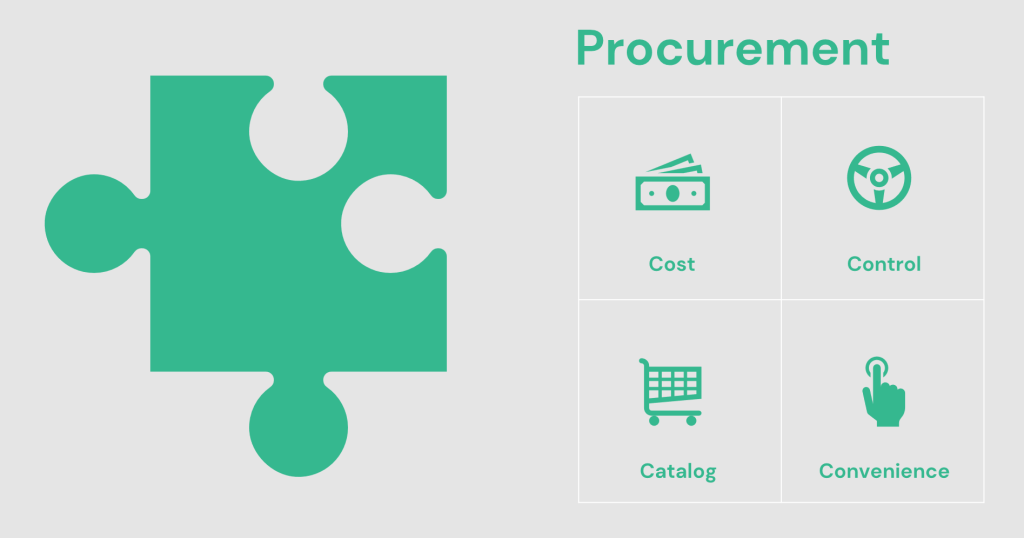The Four Cs of Procurement: Evolving for Excellence

Procurement is the backbone of any organization, serving as the crucial link between suppliers and the company’s operational needs. Traditionally, the focus has been on cost reduction, but as procurement functions mature, they expand their focus to encompass compliance, providing easy buying options (Catalog), and convenience. These are the Four Cs of procurement: Cost, Compliance, Catalog, and Convenience. Each dimension represents a critical aspect of procurement that contributes to the overall efficiency, effectiveness, and value generation within an organization.
1. Cost: The Foundational Pillar
Cost management is the bedrock of procurement. Early-stage procurement teams prioritize cost reduction to achieve immediate financial savings. However, mature procurement functions understand that effective cost management is not just about cutting expenses but also about optimizing value. This involves strategic sourcing, negotiating better terms with suppliers, and leveraging economies of scale.
Recent trends show that procurement is increasingly seen as a value creator rather than a cost center. Advanced analytics and AI are pivotal in this shift, enabling procurement teams to extract deeper insights from their data and make more informed decisions. For instance, predictive analytics helps in forecasting commodity prices and assessing supplier performance, thus driving smarter purchasing decisions.
2. Control: Maintaining Processes and standards
Control is a crucial aspect of procurement as it ensures the efficiency, transparency, and cost-effectiveness of the purchasing process. By maintaining control, organizations can prevent fraud, minimize risks, and ensure compliance with regulatory requirements. Effective control mechanisms enable accurate tracking of expenditures, adherence to budgets, and optimization of supplier relationships. This oversight helps in identifying cost-saving opportunities and enhancing the quality of goods and services procured.
Additionally, strong control frameworks support strategic decision-making, improve operational efficiency, and contribute to the overall financial health of the organization. Ultimately, control in procurement fosters accountability and sustainable business practices.
3. Catalog: Providing Easy Buying Options
In modern procurement, the term “Catalog” goes beyond maintaining a digital list of items. It involves providing easy, user-friendly buying options that streamline the procurement process. This ensures that end-users can easily find and purchase the products they need without extensive training or manual intervention.
This shift towards user-centric procurement platforms is driven by the need to enhance operational efficiency and user satisfaction. Advanced digital procurement solutions, such as no-code tools and automated purchasing systems, enable end-users to make purchases with minimal steps, thus reducing the procurement cycle time and enhancing overall productivity. These platforms also integrate with suppliers’ systems to offer real-time product availability and pricing, further simplifying the procurement process.
4. Convenience: Enhancing User Experience
Convenience in procurement translates to ease of use for the end-users within an organization. Mature procurement teams focus on simplifying the procurement process to make it as user-friendly as possible. This involves reducing bureaucratic hurdles, minimizing manual processes, and ensuring that procurement platforms are intuitive and accessible.
The trend towards no-code tools and automation is driven by the need to enhance convenience. By automating routine tasks and providing user-friendly interfaces, procurement teams can focus on strategic activities rather than being bogged down by administrative work. This not only improves productivity but also enhances user satisfaction and compliance with procurement policies.
The Future of Procurement: Integration and Innovation
The evolution of procurement is characterized by an increasing integration of advanced technologies and strategic thinking. As organizations face volatile markets and complex supply chains, procurement must become more agile and resilient. Key trends shaping the future of procurement include:
- Predictive Analytics and AI: Leveraging data to anticipate market changes and optimize procurement strategies.
- Sustainability and ESG: Integrating sustainability into procurement decisions to meet regulatory requirements and corporate social responsibility goals.
- Supplier Collaboration: Developing deeper partnerships with suppliers to drive innovation and value creation.
- Automation and Digitalization: Embracing digital tools to streamline processes and enhance efficiency.
Conclusion
The Four Cs of procurement—Cost, Compliance, Catalog, and Convenience—are critical dimensions that guide the maturity and effectiveness of procurement functions. As organizations navigate the complexities of the modern business landscape, a strategic approach to procurement that leverages advanced technologies and focuses on holistic value creation will be essential. By evolving from a cost-centric model to one that integrates compliance, easy buying options, and convenience, procurement can significantly contribute to the overall success and resilience of an organization.
In summary, the maturation of procurement involves a shift from simple cost-saving measures to a comprehensive strategy that balances cost efficiency with compliance, optimized catalog management through easy buying options, and user convenience. This holistic approach not only enhances procurement performance but also supports broader organizational goals in today’s dynamic and challenging environment.
